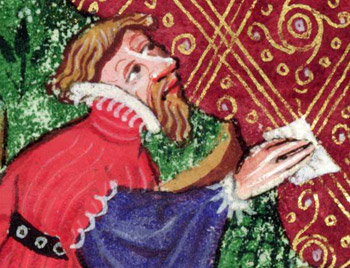Sir Landevale
General Information
Plot Summary

Sir Landevale, one of Arthur’s knights, is known for his generosity. When he falls into debt he leaves the court at Carlisle, alone and ashamed. After riding westwards he rests beside a forest and bemoans his misfortune. Two maidens approach him and summon him to speak with their mistress; he follows them to a richly decorated pavilion, where he finds a beautiful and almost naked fairy, daughter of the king of Avalon. She declares her love for him, offering him unlimited riches. He accepts, they dine and go to bed. In the morning the fairy sends Landevale away, telling him to spend liberally but warning him that if he boasts of their love he will lose her. The knight returns to Carlisle and holds feasts, helps the poor and dispenses gifts, while his fairy lover visits him in secret.
During a dance, Guinevere propositions Landevale, but he refuses to betray his king. When the queen accuses him of loving no woman, he replies that the lowliest maid of his lover is more beautiful than she. Enraged, Guinevere tells Arthur that Landevale approached her and, rejected, invented a mistress to insult her. The furious king resolves to hang the knight, who has retreated to his chamber to bemoan the boast which lost him his lover. However a jury of knights decide that, given the queen’s reputation, Landevale should be acquitted if he can present his lover and justify his claims.
On the appointed day, Landevale comes before the king and admits that he cannot summon his lover. Reluctant to execute him, the knights are debating his fate when four maidens ride into the court, each more lovely than Guinevere. Landevale admits that none of them is his lover, but the women bid Arthur prepare his court for their mistress. Realising that Landevale is about to be proved right, Guinevere urges Arthur to kill him. At that moment, however, the fairy herself rides through the streets of Carlisle towards the palace, richly dressed and covered in jewels. She enters the hall, her supreme beauty far outshining that of the queen. Claiming Landevale as her lover, the fairy informs Arthur of Guinevere’s deception and the court agrees that his boast is justified. As she prepares to leave, Landevale leaps onto her horse, and vows to go with her. She rebukes him for breaking his promise, but accepts his apology. The couple leave Carlisle and travel to the isle of Avalon, never to be seen again.
From: A. J. Bliss, ed., Sir Launfal. London: Nelson, 1960.
Manuscript: Oxford, Bodleian MS Rawlinson C86
Manuscripts
Click a title below to search for all romances in that manuscript.